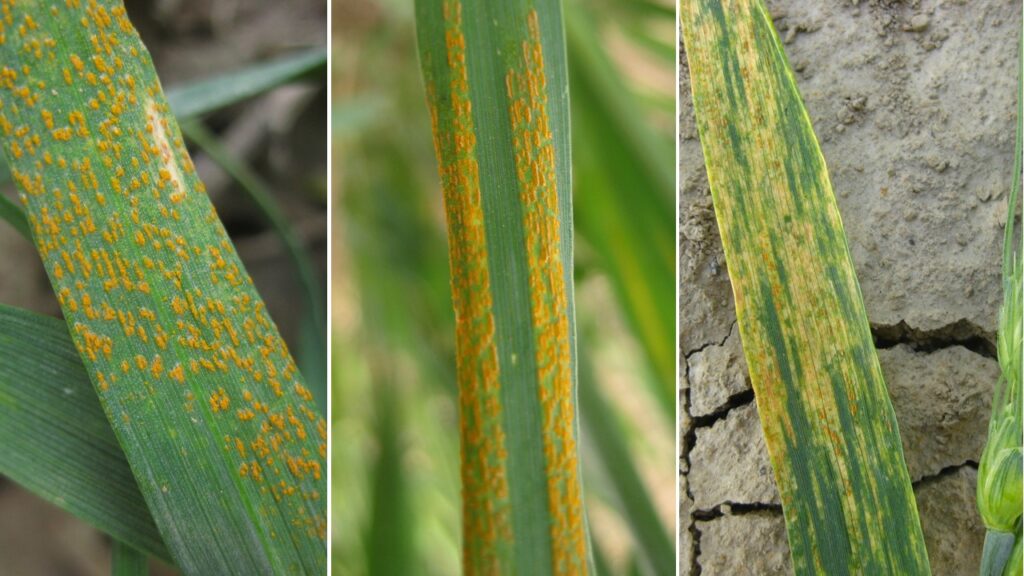By Xianming Chen
Stripe rust of wheat occurs every year in the Pacific Northwest (PNW), but the rust pressure and potential damage vary from year to year, mainly due to the variable weather conditions. Thus, the control measures can be different from year to year.
Over the last 46 years, from 1975 to 2021, the potential yield losses, which are the yield reductions in highly susceptible wheat varieties in plots allowing stripe rust to develop in comparison with plots sprayed with fungicides to protect crops, ranged from near 0 in 2021 to 90 percent in 2011, with an average loss of 34 percent. However, the average potential yield loss in the last 20 years, from 2002 to 2021, increased to 43 percent with a standard variation of 21 percent, indicating big fluctuations from year to year.
Taking the last four years as examples, stripe rust caused yield losses of 70.5 percent and 66.4 percent in 2018; 35.8 percent and 32.7 percent in 2019; 48.6 percent and 83.8 percent in 2020; and 0.8 percent and -4.0 percent in 2021 in winter and spring susceptible wheat varieties, respectively. Please note that stripe rust in the experimental fields in 2018 and 2019 was all from natural infection, whereas the fields in 2019 and 2021 were artificially inoculated with stripe rust spores. Even when the winter wheat field was inoculated twice and the spring wheat field inoculated once, stripe rust did not develop into the level of causing significant damage in 2021 due to the extremely long drought and hot weather conditions from May to July.

Stripe rust can be controlled mostly through breeding and planting resistant varieties and applying fungicides when needed. Growing resistant varieties is considered the most effective, economic, easy-to-use and environmentally friendly method of control. In the PNW, breeding for wheat varieties with resistance or tolerance to stripe rust started in the early 1960s, with the first variety, Nugaines, that had a low level of resistance, which was identified later as high-temperature, adult-plant (HTAP) resistance. During the last 20 years, almost all commercially grown varieties have at least some levels of resistance. The overall resistance in the commercially grown varieties has been able to reduce the average potential yield loss from 43 to 8 percent.
Again, taking the last four years as example, the yield losses of commercially grown winter wheat varieties were estimated as 10.1 percent in 2018, 5.5 percent in 2019, 11.6 percent in 2020 and -2.1 percent in 2021. Similarly, the yield losses of spring varieties were estimated as 13.8 percent in 2018, 2.3 percent in 2019, 10.7 percent in 2020, and 1.6 percent in 2021.
The average of 8 percent potential yield loss of commercially grown varieties is still huge for PNW wheat production. This figure indicates that on average, every year without the use of fungicides, Washington state would lose more than 15 million bushels of grain (worth more than $90 million), Idaho would lose 8 million bushels ($50 million), and Oregon would lose 5 million bushels ($30 million).
Because wheat varieties have different levels of resistance to stripe rust, not every variety needs to be sprayed with fungicides, even in years when stripe rust is a big problem, such as 2018 and 2020. Based on the yield loss data, wheat varieties are rated for necessary or unnecessary fungicide applications. The value of yield loss (in bushels per acre) of a variety divided by the least significant difference (LSD) value of the experiment is used to rate the variety. If the value is between 0 and 0.5, the variety is rated 0; from 0.5 to 1.5 is rated 1; from 1.5 to 2.5 is rated as 2 and so on. Varieties with rating of 0 do not need fungicide application, and those with ratings of 2 or higher need fungicide application. For the varieties rated 1, growers can consider how many bushels they aim to get from fungicide application, although the lower part of the yield loss range is statistically insignificant.

Wheat varieties with a high level of resistance tend to be consistently in the rating 0 group. For example, winter wheat varieties Madsen and Bobtail and spring varieties JD and WB 6121 were consistently rated 0 from 2018 to 2020. In contrast, winter wheat ARS-Crescent was rated a 2 in 2018 but a 1 in both 2019 and 2020; ORCF-102 was rated a 1 in 2018, a 3 in 2019 and a 2 in 2020; and LCS Jet was rated a 1 in 2018 and 2019 but a 3 in 2020. Spring wheat variety Kelse was rated as a 2 in 2018, a 1 in 2019 and a 5 in 2020; Whit was rated a 2 in 2018, a 1 in 2019 and a 4 in 2020; and Diva was rated a 0 in both 2018 and 2019, but a 3 in 2020. Such variations were mostly caused by the different levels of rust pressure due to weather conditions. The specificity of all-stage resistance in wheat varieties to different races of the pathogen and the level and sensitivity of HTAP resistance to the weather conditions contribute to the variations.
Due to the limitations of field space and workforce, it is not possible to include all currently grown varieties in every year’s yield loss study. However, every commercially grown variety has been tested for resistance to stripe rust before and/or after their release and rated on a 1 to 9 scale with 1 to 3 considered resistant, 4 to 5 moderately resistant, 6 to 7 moderately susceptible and 8 to 9 susceptible. This information is available in seed-buying guides. In general, varieties with ratings 1 to 3 do not need fungicide application, and varieties with ratings 8 to 9 need application. Depending upon the rust pressure, varieties with ratings 4 to 7 may or may not need fungicide application. When rust pressure is high, fungicide application is particularly needed for varieties with ratings of 6 to 7 and may be beneficial for those with ratings of 4 to 5. When rust pressure is low, fungicide application may be only beneficial for the moderately susceptible and susceptible groups.
Depending upon winter weather conditions, stripe rust can start developing either early or late. We have developed and used a set of models to predict stripe rust. In the past decade, the prediction models for potential yield losses worked very well as they were mostly in the same observed epidemic categories. These categories include low (less than 20 percent), moderate (20 to 40 percent), severe (40 to 60 percent) and extremely severe (more than 60 percent) yield losses on highly susceptible varieties. For example, in 2020, stripe rust was predicted in January to cause 44 percent yield loss and a 48 percent loss in March on the winter wheat susceptible check (PS 279); the yield loss of this variety was determined as 48.6 percent in our field experiment. Although stripe rust was predicted quite low (22 percent) in March for the 2021 crop season, the disease did not cause any significant damage due to the unusually dry and hot weather conditions from May to July.
For the 2022 growing season, our current prediction is 33 percent yield loss on the susceptible check variety based on the weather conditions from November to February. According to this prediction of a moderate epidemic, commercial varieties will likely have 0 or insignificant yield losses for the resistant group (stripe rust ratings 1 to 3, fungicide rating 0); 4 to 10 percent yield losses for the moderately resistant group (stripe rust ratings 4 to 5, fungicide rating 1); and 10 to 24 percent yield losses for the moderately susceptible and susceptible groups (stripe rust ratings 6 to 9, fungicide rating 2 and higher).
Based on our field observations of no rust in early March, the early application of fungicides at the time of herbicide application is not necessary, but late application in the flag-leaf stage will be likely needed for varieties with stripe rust ratings 6 to 9. Varieties with ratings 4 to 5 may need application in the flag-leaf stage depending upon the weather conditions from May.
Cultivar Resistance & Yield Loss Data
This article originally appeared in the April 2022 issue of Wheat Life Magazine.

Xianming Chen, Ph.D.
Xianming Chen is a research plant pathologist with the USDA-ARS and an adjunct professor at Washington State University. His research interests include foliar diseases of wheat and barley, especially rusts. He also works on epidemiology and control of rusts, including cultural, chemical, and disease resistance. His work contributes to the development of models for predicting rust epidemics. Read more about Dr. Chen.
